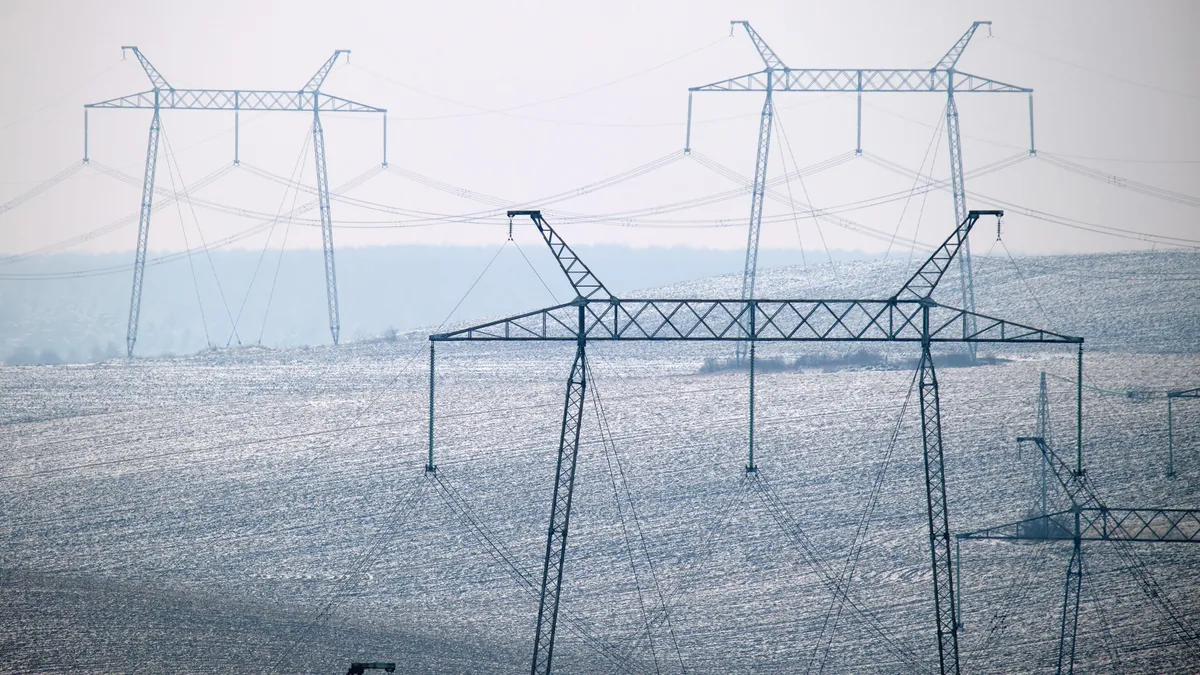Editor’s note: This story is part of the Utility Dive Outlook on 2021, a series on the trends that will shape the industry in 2021. For a look at the business trends affecting other industries, see the Dive Outlook on 2021.
The hydrogen industry has seen a significant acceleration of activity recently, with new projects, pilot studies and commercial partnerships. It has been the subject of significant attention before. This time, the hype may be warranted, analysts say, and 2021 is likely to see even more activity.
December, in particular, was "extremely busy for us," said Vinayaka Nakul Prasad, corporate strategy manager for Siemens Energy. In one month, the company launched four projects tied to Siemens Energy's electrolysis or hydrogen gas turbine businesses, dispersed across three continents. But Prasad expects even more to come in 2021.
In the coming hydrogen economy envisioned by Siemens Energy and, increasingly, other large energy industry players, Prasad doesn't see Siemens Energy's role as limited to being a manufacturer of turbines and other generation equipment. Rather, he says the company is working on solutions for use across the hydrogen value chain, from production to storage and production. And he sees a pressing need for these technologies around the globe.
Interest in hydrogen is mainly centered in two regions, according to Massimo Schiavo, a director for S&P Global Ratings — China and the European Union. China's interest, Schiavo said, stems from the country's desire to dominate global energy and technology markets. In the EU, government policy has taken center stage thanks to the EU Hydrogen Strategy, which was released last July and calls for the installation of 6 gigawatts of renewable hydrogen electrolyzers by the end of 2024, and at least 40 gigawatts by 2030.
The U.S., Schiavo believes, will be the next major player to enter the hydrogen race, and he anticipates the U.S. could release its own national hydrogen strategy sometime in 2021. Parts of the U.S., particularly in the West, have taken steps down this path, and companies from small energy startups to the world's legacy oil and gas leaders are gearing up for policy and societal changes they anticipate could generate unprecedented demand for hydrogen.
This is not the first time the world has seen industry hype for hydrogen. But this time, the need for hydrogen is no longer theoretical, according to Janet Howard, a partner at Canadian law firm Fasken. Achieving economy-wide decarbonization will require carbon-free solutions in sectors where electrification alone seems unlikely to fit the bill. The question, many now believe, is not whether the world will transition to a grid powered by a combination of renewable energy and hydrogen-based fuels. The question is how soon will the needed hydrogen become available — and how should we best use scarce supplies in the interim.
Hydrogen hype
During the last round of excitement for hydrogen, which peaked in the 2000s with President George W. Bush committing $1.2 billion to hydrogen fuel research, the enthusiasm largely centered on hydrogen-powered cars. But making transportation the focal point, Howard said, may have been part of the reason why interest eventually waned.
"The focus on transportation as a sector might have been something the market wasn't ready for, in the early days," Howard said. "There are other applications for hydrogen where there is a more natural fit."
Today, hydrogen has been reduced to a niche, according to Schiavo. "It represents just 2% of global energy consumption — it's nothing." But he, Howard and other experts expect that reality could change rapidly in the years to come.
The hype building today, Howard said, is less driven by ideology or policy — instead, she said, there is real-world demand building for hydrogen amid heavy industrial sectors that lack practical solutions for decarbonization amid growing environmental demands from customers, governments and financial players.
"There's much more focus from institutional investors, on the importance of making sure the companies that are funded are going to be sustainable long-term. There's a realization that if the companies they're invested in don't change, they will no longer be profitable," Howard said. "There wasn't that same pressure" in the 2000s.
Howard, who helped to found a hydrogen-focused advisory group at Fasken at the end of 2020, said her new hydrogen clients are a mix of entrepreneurs and institutions — legacy oil and gas companies, utilities, financiers and banks. But a large part of her clientele, she said, also comes from heavy industries such as mining, construction and agribusiness, which need hydrogen as a source of fuel to transition away from diesel.
This pressure is felt keenly in industries where efforts to reduce carbon emissions have to date remained "very modest" in the absence of viable solutions, according to Prasad, who said Siemens Energy is working with a steel plant in Austria to replace carbon with green hydrogen in its steelmaking process
Hydrogen also presents a solution for utilities faced with a need for seasonal energy storage. Pumped hydro may be the preferred means of long-term storage, Schiavo said, but it's simply not available in drier climates.
It's not just demand that may have the stars aligning for hydrogen, according to Nick Heymann, co-group head–global industrial infrastructure with financial services firm William Blair. The rapid decline in the cost of renewable energy over the last decade, and the likelihood that prices will continue to fall, means that one of the key inputs for so-called 'green' hydrogen production — renewable electricity — is finally coming within an affordable range. In some regions, he added, renewable power generation has begun to outstrip the world's ability to manufacture batteries to store it.
"We now have this surging supply of power, more ultra-low cost power than batteries can store," he said. "Suddenly, we don't have enough lithium, we don't have enough gigafactories, so instead of thinking of hydrogen as a downstream petrochemical feedstock, now it's suddenly a way to store energy."
There's also a growing sense, Howard said, that companies need to move quickly to get ahead of a coming wave of government policy that may penalize them for making insufficient progress toward decreasing carbon emissions. Members of the incoming Biden administration have indicated that tariffs or taxes on high-emission industries, such as steel or aluminum, could be on the table.
Entering the race
The need for carbon-free alternatives in sectors that are difficult to electrify, coupled with limitations on battery capacity, has begun the race for global dominance in international hydrogen markets, Heymann said. The main contenders? Currently the EU and China.
The European Union is already on track to exceed its hydrogen generation goals, established mere months ago, with plans for 20 gigawatts of hydrogen generation in place across five countries, Schiavo said. China's plans are somewhat less known to the international community, but the country is believed to be the world's current leader in hydrogen production.
"In the EU, they are totally committed to being the greenest place on the planet," Heymann said. "China is more interested in becoming the biggest economy.... I think in China's case, they see this as the technology that has legs for 30-50 years."
Schiavo believes the U.S., under the Biden administration, will move to close the gap by introducing its own strategy on hydrogen production in 2021. Or, if not during the current year, then at least within the next two to three years, he said, though recently most nations seem to be inclined toward fast-tracking hydrogen production.
"Personally, I was not expecting the EU to launch such an ambitious program in 2020," he said. "So I would not be surprised to see in 2021, that the U.S. has started to work on something, if not put something out, that is very ambitious."
Even if the U.S. doesn't create a hydrogen strategy at a national scale, efforts are underway at the state level, according to Laura Nelson, executive director of the Green Hydrogen Coalition. In December, California lawmakers introduced a bill mandating the study of hydrogen's role in the state's vision for a clean energy economy. Other state lawmakers have discussed pursuing similar legislation in 2021, Nelson said.
At the broader level, Nelson said, 11 U.S. states and two Canadian provinces recently formed the Western Green Hydrogen Initiative, which will begin meeting in March to discuss how to build momentum and infrastructure supporting the deployment of green hydrogen in the region.
The ongoing pandemic and current political push for infrastructure spending to spur economic recovery also seems poised to channel government funds to hydrogen, according to Mona Dajani, head of the hydrogen and renewable energy practices at the law firm Pillsbury Winthrop Shaw Pittman.
Based on her communications with individuals within the Biden administration, Dajani said she believes that "COVID recovery packages will be linked to energy transition packages, and those companies like oil and gas companies and utilities that are headed toward sustainability will reap significant rewards."
With industry and government now both on board for hydrogen, Dajani said, one question remains to be answered: when will the world's ability to produce hydrogen catch up to demand?
The scaling challenge
Dajani said she is aware of several large-scale hydrogen projects in the works, but not yet announced, causing her to believe the production of hydrogen could scale quickly in the coming years.
"I have a much shorter time horizon [for the growth of hydrogen production] than what I'm seeing reported," she said, "and maybe that's because you're not seeing what I'm seeing. I'm seeing major changes now... I definitely think more major stuff will start happening" in 2021.
But Heymann is slightly less optimistic, and alongside other industry analysts envisions a longer timeline to maturity for hydrogen. Even with strong government support, he said, hydrogen must still overcome two key challenges that are linked: affordability and scale.
The solution to the affordability problem, according to Schiavo, will likely come along once hydrogen electrolysis achieves the needed scale — which Schiavo and others believe will happen when individual electrolyzer units, called stacks, become sufficiently efficient to process one gigawatt of electrolysis per year.
Currently, the electrolyzers in service around the world sit at what Schiavo characterized as "pilot scale" or tens of megawatts per stack. He said he expects technology will enable stacks in the range of hundreds of megawatts each by 2025, and eventually move to even larger units.
"I'm not saying it's not possible," he said. "I'm just saying, it will probably take at least until the next decade."
Heymann agrees — the needed technologies for efficient and economical hydrogen production are on the horizon, but they aren't quite ready yet. "Remember, the electrolyzer technology is about 15-20 years behind the commercialization and reduction in cost in first solar and now wind," he said.
But electrolysis is also following a similar trend as other renewable technologies, with electrolyzer output increasing roughly ten times every four years, according to Heymann.
"In 2015, an electrolyzer produced one megawatt of power," he said. "In 2018, it was 10 megawatts, and by 2022, there is one under construction that is supposed to generate a hundred megawatts. Sometime later this decade, a gigawatt is expected."
As that level is achieved, economies of scale will bring hydrogen supplies in line with demand and allow prices to drop as the industry observed with wind and solar, Dajani said. That, in turn, could open up even more uses of hydrogen outside of niches that are currently limited to the resource out of necessity.
To achieve this vision, Schiavo said, will also require a rapid increase in the availability of renewable energy the likes of which just isn't possible on a short time scale. Even if the U.S. made a massive investment in renewable energy today, he said, it would still take 2-3 years to deploy sufficient renewables to fuel hydrogen production in a cost-efficient manner.
Transition strategy
The need for increased renewable energy generation, coupled with challenges with respect to storage and transportation of hydrogen, means making the leap directly to green hydrogen from fossil fuels is likely impossible, Heymann said.
This reality has many industry leaders considering intermediate steps that could enable economies to build out hydrogen infrastructure while waiting for the actual green hydrogen itself to achieve scale.
Unlike green hydrogen production, which uses electricity from renewable sources to split water into its chemical components — hydrogen and oxygen — gray hydrogen is derived directly from fossil fuels, typically by splitting natural gas into its own chemical components, carbon and hydrogen. Blue hydrogen is derived from fossil fuels in a similar fashion as gray, but paired with sequestration to capture the carbon emissions this form of hydrogen production generates.
Both gray and blue hydrogen are currently cheaper to produce than green hydrogen, so some countries, including China, are using gray hydrogen to prompt the development of hydrogen-compatible infrastructure, according to Schiavo. The line of thinking is that this approach will enable the development of pipelines and other infrastructure compatible with hydrogen, so that when green hydrogen does become more widely available, China will be ready for widespread distribution. But in environmentally-minded regions such as the EU, gray and blue hydrogen lack social acceptance.
Some see a third opportunity to build out hydrogen infrastructure and make scarce supplies go further — blending green hydrogen with natural gas. Hydrogen blending is thought to come with the advantage of decreasing transition costs by making use of existing infrastructure, because so long as the hydrogen inclusion remains low, the blend can be added to pipelines and burned in natural gas turbines. This transition strategy has gained steam particularly in the U.S. and Canada, where access to natural gas means hydrogen could struggle to compete on the basis of cost for years to come. And proponents of blending argue it keeps costs low and enables a gradual replacement of gas infrastructure as hydrogen inclusion rates increase.
"Natural gas is a quick way to start down the path," Howard said, "so hopefully people get comfortable with that."
Some environmental groups are, however, decidedly not comfortable with gas-hydrogen blending.
"One of the questions, with hydrogen combustion in gas plants, is whether this is a plan or a ploy. That is a pressing question," said Lewis Milford, president of the Clean Energy Group, a nonprofit advocacy organization. "Are these proposals to blend hydrogen in gas plants serious operations, or are they a way to preserve at-risk stranded assets?"
Milford points out that while green hydrogen may be carbon-free, it isn't necessarily emissions-free. The high temperature of hydrogen combustion can trigger nitrogen fixation and produce NOx. When hydrogen is blended with natural gas, the high flame temperature may actually increase NOx emissions, according to Milford. Additionally, he says, the blends don't result in a complete reduction of carbon emissions, and the gas plants where this blending would take place are often located near communities of color that already face disproportionate environmental burdens.
"This is of obvious concern," Milford said. "The last thing we should be doing is experimenting with new forms of pollution combustion in cities where" disadvantaged populations will be affected.
Milford said he believes gas-hydrogen blending proposals should not receive government permits until the potential environmental impacts are fully understood, and technology for mitigating the NOx emissions from hydrogen becomes available.
Prasad doesn't deny that burning hydrogen comes with additional NOx emissions. "Of course there's a NOx concern," he said, adding that SiemensEnergy is working on efficient combustor designs and other technologies to control these emissions. He also acknowledged that hydrogen blending with gas does not result in a 1-1 carbon reduction. Rather, a 60% hydrogen inclusion will reduce carbon emissions by about 30%, he said.
These questions about the best way to utilize, and transition to, hydrogen remain unanswered, and specifics aren't likely to emerge by the end of 2021, Heymann said. But at a higher level, he said, the future of hydrogen no longer seems speculative.
"We're no longer out in the desert, wondering which way to walk," Heymann said. "I don't think we're in that environment today. There's a very clearly delineated path.... The question is, are you positioned to benefit from this change, or are you going to get run over by it?"




















